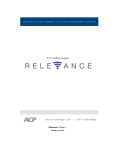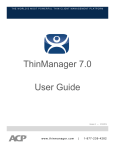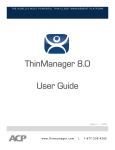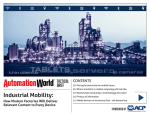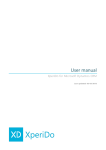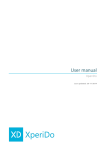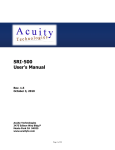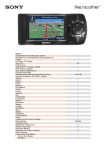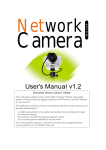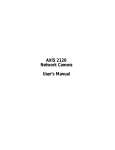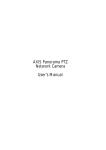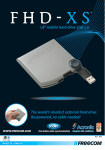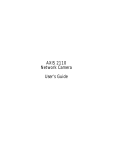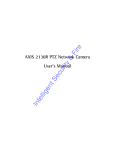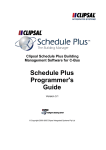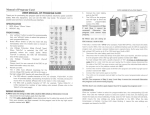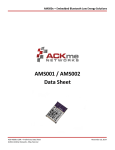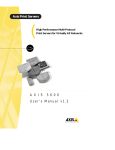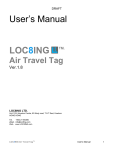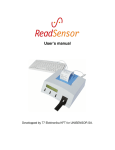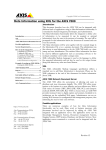Download Relevance User Manual
Transcript
Relevance for ThinManager 8 May 15, 2015 Relevance User Manual 1. Introduction to Relevance ...................................................................................................................... 4 2. Convert an Existing System ................................................................................................................... 4 2.1. Upgrading an existing ThinManager System ................................................................................. 4 2.2. The ThinManager Interface ............................................................................................................ 5 2.3. Menus ............................................................................................................................................. 7 2.4. Upgrading an Existing Configuration .............................................................................................. 9 2.5. Adding a Location ......................................................................................................................... 10 2.5.1. 2.6. Location Configuration Wizard .................................................................................................. 11 Adding a Location to a Terminal ................................................................................................... 21 3. Using Mobile Devices to Interact with Relevance ................................................................................ 29 3.1. Configuring Mobile Device in ThinManager ................................................................................. 30 3.2. Configuring an iPad for Relevance ............................................................................................... 39 3.2.1. 3.3. Associating the iPad to the Configuration ................................................................................. 43 Configuring an Android for ThinManager ..................................................................................... 46 4. Manual Interaction with Locations ....................................................................................................... 50 4.1. Shadow ......................................................................................................................................... 51 4.2. Transfer ........................................................................................................................................ 57 4.2.1. 4.3. Transfer at the Location ............................................................................................................ 60 Clone ............................................................................................................................................ 62 5. Using the Mobile Device to Add Resolver Codes ................................................................................ 65 5.1. QR Codes ..................................................................................................................................... 65 5.2. Bluetooth Beacons........................................................................................................................ 71 5.3. Wi-Fi Access Points ...................................................................................................................... 80 5.4. GPS .............................................................................................................................................. 88 6. Adding Actions to Resolver Codes ...................................................................................................... 96 7. Interacting with the Location .............................................................................................................. 100 7.1. Shadow ....................................................................................................................................... 101 7.2. Forced Transfer .......................................................................................................................... 103 7.3. Transfer ...................................................................................................................................... 107 7.4. Clone .......................................................................................................................................... 111 8. Unassigned Locations........................................................................................................................ 114 8.1. Create a Location ....................................................................................................................... 114 9. Fencing and Sub-Locations ............................................................................................................... 124 9.1. Parent Locations ............................................................................................................................ 125 9.2. Child Sub-Locations ....................................................................................................................... 129 Relevance User Manual -2- 10. Relevance User Access ................................................................................................................. 135 10.1. Create Access Groups ............................................................................................................ 136 10.1.1. Create Access Group using Windows Security Group........................................................ 138 10.2. Apply Permissions to a Display Client Application.................................................................. 141 10.3. Create Relevance Users ......................................................................................................... 143 10.3.1. Create the TermSecure User without a Domain ................................................................. 144 10.3.2. Create the TermSecure User with a Domain ...................................................................... 146 11. Creating a Location with Restricted Applications. .......................................................................... 152 11.1. Using Permission to Restrict an Application ............................................................................... 152 11.2. Adding a Restricted Application to a Location ............................................................................ 154 11.3. Putting it Together ...................................................................................................................... 159 12. One QR Code, Multiple Actions ..................................................................................................... 163 13. Calculating Permissions ................................................................................................................. 166 14. TermMon ActiveX and Relevance.................................................................................................. 168 15. Guided Access on the iPad ............................................................................................................ 169 Relevance User Manual -3- 1. Introduction to Relevance Relevance is mobile computing based on location. This isn’t just sending an application to a mobile device, but is a way to enable the location to determine the content sent to the device. The mobile device allows the user to interact with the location. Relevance is the How to provide What you need, Where and When you need it. There are two types of locations in Relevance, Assigned and Unassigned. Assigned locations are locations that have a terminal and monitor at the given location, much like traditional computing. Relevance adds additional functions to the location that allows mobile devices to interact with the location and Shadow the terminal, Clone the applications, or Transfer the control of the location to the mobile device. Unassigned locations are locations that lack a permanent terminal and monitor and all of the content is sent to the mobile device. Relevance is an extension of ThinManager and adds a new feature set to ThinManager when a Relevance license is added to a ThinManager license. It is helpful to know and understand ThinManager before deploying or converting to Relevance. Please see the ThinManager documentation for details on ThinManager. 2. Convert an Existing System 2.1. Upgrading an existing ThinManager System Un-synchronize your ThinManager Servers if they are a synchronized pair. Do this at Manage > ThinManager Server List > Auto-synchronization Selection and uncheck the Automatic Synchronization checkbox. Don’t re-synch them until both of the pair have the same version installed. Backup the configuration on your Primary ThinManager Server by selecting Manage > Backup Configuration. This will give you an unsynchronized backup configuration if something goes wrong. Install the ThinManager software on each ThinManager Server using the Install Mode, either using the Install Application on Terminal Server on a 2008/2012 server or with the change user /install command. Synchronize your ThinManager Servers once they are both updated if they were synchronized before. Synchronize at Manage > ThinManager Server List > Auto-synchronization Selection and check the Automatic Synchronization checkbox. Update the ThinManager license with a license that contains Relevance by going to the ThinManager License site and reactivating your master license with the updated installation ID. The master license and installation ID are found in the Licensing window that is opened by selecting Install > Licenses from the ThinManager menu. Relevance User Manual -4- 2.2. The ThinManager Interface The ThinManager interface was changed in ThinManager 7.0 to a style based on the Microsoft Outlook template. This section will lead you through the important sections. You may find specific information by pressing the F1 key while in the ThinManager program. ThinManager Interface The ThinManager Interface has several components. 1. Application Button – This launches the ThinManager Server Configuration wizard to configure global ThinManager settings. 2. Quick Access Toolbar – This lets you add icons of commonly used tasks from the menu bar, like Restart, Send Message, Modify, Backup, and Shadow. Select the Quick Access drop-down arrow to customize this tool bar. 3. Menu Bar – The menu bar separates the functions into categories. 4. Ribbon Bar – The menu bar now has the ribbon with icons for the functions. The ribbon can remain visible or hidden when unused. This is controlled by the Minimize the Ribbon command on the Quick Access drop-down arrow menu. 5. Detail Pane Tabs - The Detail Pane has tabs that allow you to choose what details you want to display. The tabs and detail selections change depending on what is selected in the tree. You can drag the tabs to change the order. 6. Detail Pane – The Detail Pane displays the information for the selected tab for the highlighted tree component. You can tear away the detail pane by dragging the tab away from ThinManager. You can re-dock the pane by dragging the pane title bar back to the tabs. Relevance User Manual -5- 7. Tree – The tree shows the components of ThinManager. The tree now uses the Outlook Bar Tab control so the branches of the ThinManager tree are shown one at a time. 8. Tree Selector – The selector buttons at the bottom of the tree control select which branch is active and visible. These can be pulled upwards to stack the buttons, or pulled down to minimize the buttons. Tree Selector Buttons Minimized Buttons at the Bottom Buttons Stacked Stacking the buttons is provides quicker switching but the minimized buttons allows more room to show components in a larger system There is an arrow that allows customization, tasks like hiding branches or reordering the branches of the tree Relevance User Manual -6- 2.3. Menus The menus of ThinManager use the Microsoft Outlook ribbon but contain similar functions as previous versions. This is a brief description. Many of these functions will be explained in greater details in the sections of the manual that cover setup and configuration. Edit Edit includes common editing commands and buttons to Add ThinManager Servers, Remove, Refresh, and Modify. There is a Find and Find Next button to allow you to search the tree. Manage Manage includes common management commands with icons for Packages, PXE Server, ThinManager Server List, DNS, Web access, and TermSecure Access Group management: The Manage IDs is a new feature to manage Location IDs for Relevance. Install Install includes common commands with icons for installing Firmware Packages, Modules, Licenses, the TermCap database and Reports. Relevance User Manual -7- Tools Tools include common commands with icons for Restarts, Reboots, Touchscreen Calibration, Disabling, Enabling, and clearing the event log. View View includes common commands with icons like Reports, Applications, and Tabs. Reports open the Select Reports window. Application lets you select the theme for the new ThinManager interface, and Tabs allows you to pick the look of the detail pane tabs. Remote View Remote View includes common commands with icons like Interactive, Scaled to Window, Go Full Screen, Send Keys, and Connect Options. Be careful with Go Full Screen. This will make the shadowed terminal’s image full screen. Although this can be reversed by selecting the CTL+ALT+Break buttons it is often forgotten. If you go full screen and forget the key sequence use ALT+F4 to close ThinManager. It will close the full screen session. Help includes About ThinManager which shows the version and build number of ThinManager. Relevance User Manual -8- 2.4. Upgrading an Existing Configuration The current configuration in the example was created in ThinManager 7 and upgraded to ThinManager 8. Each terminal is logging in with a Windows account and is running two display clients, HMI_New and either Reports or Form03. Terminal Tree The terminals can continue to run in this configuration but they don’t gain any of the Relevance features or functions. Relevance User Manual -9- 2.5. Adding a Location In ThinManager you deploy applications by defining a terminal, configuring it with applications and a user account. This allows the operator to access the applications needed. ThinManager Deployment The new Relevance method will add a location. The application and user account will be added to the location. First Relevance Deployment The first task is to create a location and re-apply the application and user account to the location which will then be assigned to the terminal. Relevance User Manual - 10 - 2.5.1. Location Configuration Wizard Open the Locations branch by selecting the Location icon, the globe, in the Tree Selector at the bottom of the tree. Location Configuration Wizard Right click on the globe Locations icon in the tree and select Add Location to open the Location Configuration Wizard. Name the location. Select Next to continue. Relevance User Manual - 11 - Location Options Page The Location Options page has several configurable options that control the remote access. Inactivity Timeout – A Relevance user will be logged off after this interval if inactive. Relevance ID Signal Loss Timeout – This is the interval before a Relevance user is logged off due to lack of a signal. Activate Display Client at Log In – This brings the display client to the forefront when the Relevance user logs in. Enforce Location Fencing – This controls access in an area with nested locations. If local fencing is enforced the user has to be within the fence to access the sub-locations. Inherit from parent Locations – This allows nested sub-locations to inherit the parent display clients. Allow Local Access – This allows a Relevance user to access the location from that location. Unchecking this will only allow remote access. Allow Remote Connection - This allows a Relevance user to access the location from a remote site. Unchecking this will only allow access at the location. Reset Cloned Sessions on Logout – This will close any cloned sessions once they are disconnected. Relevance User Manual - 12 - Allow Location to be selected manually – This allows a location to be manually selected. Unchecking this will require the Relevance user to use a Resolver like QR Codes, Wi-Fi, or Bluetooth to initiate the location access. Checking the Allow Location to be selected manually checkbox reveals other settings. Location Options Page Allow Manually Selected Location Actions – These are the actions you can manually select. You can allow all, or none. Allow Shadowing – This allows a duplicate of the display to be shown on the mobile device. Allow Cloning – This allows the user to launch the same applications as the location but using their Windows account. Allow Transfer – This allows the display to be moved from the location to the mobile device. The defaults are fine but you have the option to customize the settings as needed. Relevance User Manual - 13 - Terminal Server Selection This example will replace the display clients of the terminal with the same display clients on the location. Apply the desired display clients to the location and select Next to continue. Relevance User Manual - 14 - Window Log In Information Page A location with a display client will require a Windows username. Enter a valid Windows username in the Username field. Enter the password in the Password and Verify Password fields. ThinManager 8 introduces Active Directory integration to ThinManager that is explained in detail in the ThinManager documentation. The Log In Information page has Search, Verify, and Password Options buttons. The Search button will open the Search for AD User window. Relevance User Manual - 15 - Search for AD User The Search for AD User window allows you to reference users from the Active Directory. Click the Locations… button to choose where to select users. Select AD Location to Search Clicking the Locations… button will launch the Select AD Location to Search window. Highlight the domain branch you want to use and select the OK button. Relevance User Manual - 16 - Search for AD User Window Highlighting the domain branch you want to use and select the OK button will add the Location for the search. Selecting the Search button will fetch the user accounts and populate the Search for AD User window. Populated Search for AD User Window Highlight the domain user you want and select the OK button. This will reference the user for the terminal log in account. Relevance User Manual - 17 - Window Log In Information Page The Location will now use a Active Directory user account. Select Next to continue. Relevance User Manual - 18 - Relevance Resolver Selection Page The Relevance Resolver Selection page allows the association of Resolvers to the location. Resolvers include Bar Codes QR Codes Bluetooth Beacons Wi-Fi Access Points GPS We will explain the configuration of Relevance Resolvers later. See Using the Mobile Device to Add Resolver Codes at page 65. Select the Finish button to create the Location. Relevance User Manual - 19 - Location with Assigned Display Clients The Location tree will show the created Locations and the display clients assigned to it. Relevance User Manual - 20 - 2.6. Adding a Location to a Terminal Now the newly created location needs to be attached to a terminal. Terminal Configuration Wizard Select the Terminal icon on the Tree Selector at the bottom of the tree to open the Terminals branch. Highlight a terminal and double click or select Modify to open the Terminal Configuration Wizard. Relevance User Manual - 21 - Terminal Mode Selection Page Navigate to the Terminal Mode Selection page. There are two Relevance checkboxes. Enable Relevance User Services – This uses the ThinManager TermSecure Access to control access to applications. Enable Relevance Location Services – This allows the terminal to use Locations in its configuration. Check the Enable Relevance Location Services checkbox to use Locations. Select Next to navigate to the Display Client Selection page. Relevance User Manual - 22 - Remove Display Clients on the Display Client Selection Page Remove the existing display clients from the terminal by highlighting them and selecting the left arrow button. The user will access the display clients through the location, not the terminal. Select Next and continue to the Relevance Options page. Relevance User Manual - 23 - Relevance Options Page Select the Options before choosing a location. Once the Location is assigned the Options are locked. Select the Options before choosing a location. If you need to change an option you can clear the location with the Clear button, change the option, and then re-assign the Location. The Options include: Allow Selection of the Location manually – This will let the user select the location manually from a menu on the mobile device. If this is unselected then the user must use a Resolver. Enable Resolver Types – Relevance has several methods of resolving the location to allow specific applications to get sent to specific locations. Enable QR Code Location Ids – This allows the scanning of a QR code to determine the location. Enable Bluetooth Locations – This allows the use of Bluetooth beacons to determine the location. Enable GPS Locations– This allows the Global Positioning System of the mobile device to determine the location. Enable Wi-Fi Locations – This allows the signal strength of Wi-Fi access points to determine the location. Each method selected will require configuration to associate a location with the Resolver data. Relevance User Manual - 24 - Select the Change button to open the Select Location window. Select Location Window The created Locations will be displayed in the Select Location tree. Highlight the desired Location and select the OK button. Relevance User Manual - 25 - Location Assigned . Once the Location is assigned the Options are locked. If you need to change an option you can clear the location with the Clear button, change the option, and then re-assign the Location. Once the location is assigned select Next and navigate to the Log In Information page. Relevance User Manual - 26 - Log In Information Page The terminal was assigned a user account to allow it to log in to the servers. This is not needed because the user account is assigned to the location. Clear the Username and Password fields. Once the Username is cleared select the Finish button to complete the wizard. Apply the changes. Right click on the terminal in the tree and select Restart Terminal to load the new configuration. Relevance User Manual - 27 - Locations on Terminals in Terminal Tree The application is now running on the location which is assigned to the terminal. The tree will show location icons to show what display clients are from the location. In this example the terminals are using locations. The 3_Terminal doesn’t show locations because it is an older Package 5 terminal and Relevance requires Package 6 or later. The user should see no difference in the application deployment using Locations than when the application was assigned to the terminal. Relevance makes changes when a mobile device is added to the system. Relevance User Manual - 28 - 3. Using Mobile Devices to Interact with Relevance Adding a location to a terminal doesn’t seem like it makes any difference. The application runs the same on the terminal versus a location on a terminal. The difference is the interaction a user can have with that location using a mobile device. Relevance uses Resolvers to define the location. Manual Selection – This allows user select the location manually from a menu on the mobile device. QR Code – QR codes can be created to define a location. Bluetooth – This allows the use of Bluetooth beacons to determine the location. GPS – This allows the Global Positioning System of the mobile device to determine the location. Wi-Fi – This allows the signal strength of Wi-Fi access points to determine the location. iBeacon – This is an Apple version of Bluetooth Resolvers are identified and marked using the mobile device so it is important to configure a mobile device for identifying the resolvers in Relevance Note: The iTMC application can be installed for free from the Apple App store. The AndroidTMC application can be downloaded for free from the ThinManager web site at http://downloads.thinmanager.com/ Relevance User Manual - 29 - 3.1. Configuring Mobile Device in ThinManager A configuration needs to be created in ThinManager so that the mobile device can join the system as a terminal. ThinManager Terminal Configuration Wizard Open ThinManager. Select the Terminal icon to show the Terminal branch of the tree. Right click on the Terminals branch and select Add Terminal to launch the Terminal Configuration wizard. Enter a name for your mobile device and select Next. Relevance User Manual - 30 - Terminal Hardware Page Select your make and model of hardware. An iPad is Apple / iOS. An Android Device is GENERIC / Android Device. Navigate to the Terminal Mode Selection page by clicking Next. Relevance User Manual - 31 - Terminal Options Page Terminal Options Page of the Terminal Configuration Wizard The Terminal Options page has a few settings of interest. Allow replacement at terminal if offline – This allows the terminal to show up in the replacement list during a new terminal connection Put Terminal in Admin Mode at Startup – This turns the terminal on without showing the display clients. This is useful to use as the terminal to register HID cards or registering fingerprint scans. Set Schedule – This will allow the Schedule button to become active. Enable Terminal Effects - This allows the desktops in MultiSession to slide smoothly into the desktop instead of appearing instantaneously. Show terminal status messages - This allows the terminal to display status messages in the upper left corner of the screen. Allow terminal to be shadowed – This dropdown sets the Shadowing setting allowing the configuration of Shadowing Options. o No – This will prevent the terminal from being shadowed by anyone. o Ask – This will ask the user to allow shadowing. The user will need to say Yes on a message window before the shadowing is allowed. o Warn - Will display a message window alerting the terminal that it is to be shadowed, but doesn’t require user input before the shadowing is allowed. o Yes – Will allow shadowing to occur without warning or user input. Relevance User Manual - 32 - Allow Interactive Shadow – This allows users with Shadowing permission to interactively shadow the terminal. Select the Next button to configure the configuration. Terminal Mode Selection Check Enable Relevance User Services to use Relevance Access to control access to applications. Check Enable Relevance Location Services to allow the device to use Locations. Select Next. Relevance User Manual - 33 - Display Client Selection Page The mobile device can have display clients assigned to it permanently, and then access others with Relevance. This example will leave the display clients off of the mobile device to show the effect of Relevance more clearly. Leave the Selected Display Clients list empty on the Display Client Selection page. Select Next to navigate to the Relevance Options page. Relevance User Manual - 34 - Relevance Options Select the Resolvers you want to use, including the Allow selection of Location manually checkbox. You can start with one resolver and add the others as you deploy them, or start with all the resolvers selected and remove the ones you chose not to use. The central management of ThinManager and Relevance make changes to configuration easy. Options Allow Selection of Location manually – This checkbox lets a location be selected manually from the mobile device menu. If unselected you must use a resolver to select the location. Enable Resolver Types Enable QR Code Location IDs– This checkbox allows the mobile device to scan QR codes as resolvers. Enable Bluetooth Locations– This checkbox allows the mobile device to use Bluetooth beacons as resolvers. Enable GPS Locations– This checkbox allows the mobile device to use GPS settings as resolvers. Enable Wi-Fi Locations– This checkbox allows Wi-Fi connection to be used as a resolver. Resolver Update interval – This is the frequency that the resolver updates. Confirm before entering a location – This checkbox enables a dialog box that will be shown each time a user enters an area.. Select Next to navigate to the Log In Information page. Relevance User Manual - 35 - Log In Information Page Enter a user name in the Username field. Enter the password in the Password and Verify Password fields. You may use the Search button to reference an Active Directory account as shown in Location Configuration Wizard on page 11. Relevance User Manual - 36 - Video Resolution of the Terminal Configuration Wizard The Video Resolution page of the Terminal Configuration Wizard lets you chose the Resolution, and Color Depth. There is no refresh rate for mobile devices. The resolutions in the dropdown are dependent on the make and model of hardware used. Select the Next button to configure the configuration. Relevance User Manual - 37 - Mobile Device Options The Mobile Device Options window has several settings that control the user experience on mobile devices. This page allows you to disable features normally displayed in the mobile apps. Toolbar Buttons Show Scan Data Button – This checkbox, when unselected, will hide the Scan Data button. Show Scan Resolver Button– This checkbox, when unselected, will hide the Scan Resolver button. Show User Login Button– This checkbox, when unselected, will hide the User Login button. Sound Options Play Location Sounds – This checkbox, when selected, will play a sound when a location is entered.. Play User Login Sounds – This checkbox, when selected, will play a sound when the user logs in as a TermSecure or Relevance user. User Interface Settings Show Zoom Map – This checkbox, when unselected, will hide the screen map while zooming. Show Toolbar – This checkbox, when unselected, will hide the app toolbar. Allow Exit to ThinManager Server List – This checkbox, when unselected, will prevent the user from leaving the app to switch ThinManager Servers. Select Finish to complete the configuration of the mobile terminal. Relevance User Manual - 38 - 3.2. Configuring an iPad for Relevance The iPad needs to have the iTMC client installed. The iTMC application can be downloaded from the Apple App Store for free. ThinManager in the Apple App Store Go to the Apple App Store. Enter ThinManager in the search field. Select the iTMC application and select Open. It will download and install on your iPad. The ThinManager app shown on the left is the ThinManager Mobile app that lets you control ThinManager from a mobile device. The iTMC application is on the right. Relevance User Manual - 39 - ThinManager iTMC Configuration Screen Select the Settings button at the bottom to launch the Settings page. Relevance User Manual - 40 - Settings Page Select Add ThinManager Server to launch the Add ThinManager Server page. Relevance User Manual - 41 - Add ThinManager Server Page Enter your ThinManager Server name in the Description field. Enter the IP address of the ThinServers (usually the ThinManager Server) in the Primary ThinServer IP field. Enter the IP address of a secondary ThinManager Server, if you have one. Select the Save button in the corner. This will return you to the Settings page. Select the Configurations button in the top left corner to return to the configurations screen. Relevance User Manual - 42 - 3.2.1. Associating the iPad to the Configuration Once the ThinManager Server is defined on the iPad you need to associate the hardware to the iTMC configuration you created. Defined ThinManager Servers The defined ThinManager Server will be displayed on the configuration screen. Select the ThinManager Server. You will be connected to the ThinManager Server. Relevance User Manual - 43 - Pick Replacement A Pick Replacement window will be shown allowing you to select the newly created terminal configuration or to launch the Terminal Configuration Wizard by selecting Create New Terminal. Touch your newly defined terminal to choose the configuration you created for the iPad. This will tie the mobile device to the configuration in ThinManager. Relevance User Manual - 44 - ThinManager iTMC Home Screen The terminal will be connected, logged on, but no applications are running because we left that blank. A dialog will open stating that “iTMC Would Like to Use Your Current Location”. This enables the GPS location tool. Allow the “Use Current Location” to enable GPS as a resolver on this mobile device. Select the OK button to allow GPS as a resolver. Relevance User Manual - 45 - 3.3. Configuring an Android for ThinManager The Android device needs to have the AndroidTMC client installed. The AndroidTMC application can be downloaded from the ThinManager Download page at http://downloads.thinmanager.com/ . Android ThinManager Compatible thin client on an Android Desktop The AndroidTMC program is launched from an icon on the desktop. The first action will be to define the ThinManager Server. Add ThinManager Server Window The Add ThinManager Server window will launch with fields for the ThinManager Server name and IP address. Relevance User Manual - 46 - Enter ThinManager in the Title field and the IP address of the Primary and Secondary ThinManager Server in the Primary and Secondary address field and select Done. If you have only one ThinManager Server you will need to select the Next button to cycle to the Done button. Add ThinManager Server Window Select the Add button and the AndroidTMC app has your ThinManager Server listed. 1.1.1. Associating the Android Device to the Configuration Once the ThinManager Server is defined on the iPad you need to associate the hardware to the iTMC configuration you created. AndroidTMC Start Screen The AndroidTMC Start Screen will show the registered ThinManager Server. Touch the ThinManager Server to connect. Relevance User Manual - 47 - Connecting Status The AndroidTMC will connect to the ThinManager Server. Select a Terminal to Replace Once the AndroidTMC had connected to the ThinManager Server you will get the Select a Terminal to Replace window. You may choose an existing terminal configuration or you may choose Create New Terminal. If you choose Create New Terminal then a Terminal Configuration Wizard will launch on the ThinManager Server that will let you configure the AndroidTMC as a new terminal. Relevance User Manual - 48 - AndroidTMC Client Once connected the Android device will display the applications assigned in ThinManager. Relevance User Manual - 49 - 4. Manual Interaction with Locations A mobile device can connect to a Location and manually interact with the applications. Manual Interactions with a Location The three manual interactions between a mobile device and a location are: Shadow – Shadowing duplicates the graphic output of the Location screen and sends it to the mobile device. Transfer – Transferring sends the graphic output of the location to the mobile device instead of the location. This requires the operator to manually allow the transfer. Clone – Cloning will create a duplicate session for the mobile device using the configuration of the location and the user credentials of the mobile device. Relevance User Manual - 50 - 4.1. Shadow Shadowing duplicates the graphic output of the location and sends it to the mobile device. Shadowing The mobile user will see the exact display as the location. Relevance User Manual - 51 - Open the iTMC program, select your ThinManager Server, and touch the Menu button in the upper right corner to launch the Main Menu window. Main Menu Touch the Login Locations on the menu to open the Select Location window. Relevance User Manual - 52 - Select Location Menu Select a location to open the Select Action window. Relevance User Manual - 53 - Select Action Window The Select Action window will list the actions that are allowed at the location. Touch Shadow. Relevance User Manual - 54 - iTMC Shadowing Location The screen should show the shadow of the location. Relevance User Manual - 55 - Single Display Client Shown in Shadow The shadow will only show one display client window because you are shadowing the location and are receiving the current graphic output from the location. Touch Leave to end the shadow. Relevance User Manual - 56 - 4.2. Transfer Transfer is similar to Shadow except that the user has to allow the transfer at the location. Transfer This prevents someone from taking the session while the operator is busy with a process. It also allows a mobile user to take sole control of the location. Relevance User Manual - 57 - Open the iTMC program, select your ThinManager Server, and touch the Menu button in the upper right corner to launch the Main Menu window. Touch the Login Locations on the menu to open the Select Location window. Touch a location to open the Select Action window. Select Action Window Select Transfer from the Select Action window. Relevance User Manual - 58 - Wait for Transfer Permission Message The user of the location will need to allow the transfer. Relevance User Manual - 59 - 4.2.1. Transfer at the Location A dialog box will be displayed at the location to allow the transfer. Location Logoff Dialog Box Select the Yes button to allow the transfer. The iTMC client will be allowed to display the location display. Transferred Location Display The Transfer will show all the display clients on the location instead of just showing the display output of the location The location display can be restored from the iTMC client or the location. Selecting the Leave button on the iTMC client menu will restore the display back to the location. Selecting the Restore Location button at the location will also restore the display. Relevance User Manual - 60 - Main Menu at the Location Go to the location. Select Restore Location. This will launch a dialog box on the iTMC client to warn the mobile user that they will be losing the transfer. Location Logoff Dialog When the user at the location selects the Restore Transfer button a warning message will be sent to the mobile device. The mobile user can select Yes to allow the transfer back to the original location, No to refuse the restoration, or they can select the More Time button to delay the restoration. Select Yes to allow the transfer back to the location. Relevance User Manual - 61 - 4.3. Clone Clone will duplicate the display clients of the location on the mobile device but the sessions will be created with the mobile device Windows user account. Clone This allows a mobile user to get the HMI or other software and have independence from the user at the location. Relevance User Manual - 62 - Open the iTMC program, select your ThinManager Server, and touch the Menu button in the upper right corner to launch the Main Menu window. Touch the Login Locations on the menu to open the Select Location window. Touch a location to open the Select Action window. Select Clone. A new session will be created using the credentials from the iTMC configuration. Cloned Session Touch Leave in the top corner to close the iTMC client. Relevance User Manual - 63 - Note on Licenses: Relevance requires a ThinManager system with a Relevance License installed. Terminals connecting to Microsoft terminal servers and running applications will require TS/RDS CALs and application licenses. Relevance requires a mobile device configured as a terminal. This mobile device requires a ThinManager XLi license. An application license and a Microsoft TS/RDS CAL are needed for cloning as the terminal is starting a session on a terminal server and starting an application. Transfer and shadow do not necessarily require an additional application license and TS/RDS CAL as they are only viewing the output already sent to the terminal/location Relevance User Manual - 64 - 5. Using the Mobile Device to Add Resolver Codes Resolvers help a mobile device know what location it is in. These can be configured to tell the mobile device what action to take. Resolvers include QR Codes Bluetooth Beacons Wi-Fi Access Points GPS Assignment of Resolvers Resolvers can only be assigned to one location, but each location can have more than one Resolver and action assigned. Additionally, you may use Permissions and assign a resolver several times with a different action tied to each permission. Fencing uses combinations of resolvers to limit actions to specific locations. An action may require being in an area can be covered by a Bluetooth beacon of GPS site before a QR code can be scanned. This can prevent a user from walking away from an area with a critical process. The Fence prevent the user from running the application out of the assigned ares. 5.1. QR Codes Quick Response Codes are an improved barcode. They can store text, numeral data, and URLs. These can be read quickly and easily. There are many programs which generate them, including free sites on the web. QR Codes provide pinpoint location as you need to be at the QR code to read it. This allows you a high degree of granularity in your configuration. You can put QR Codes anywhere, and not worry about overlap of signals or interference. One issue with QR Codes is that they are easy to copy. If you rely on Relevance to make sure an operator is in a particular location, when you have some doubt about their trustworthiness, then QR Codes would likely need to be coupled with other devices like Wi-Fi, GPS, or Bluetooth, to provide some nesting or fencing, as we’ll explain in detail later. The iTMC program and AndroidTMC use the build in camera as a scanner to read the QR codes. The procedure is: Create the QR codes. Launch the iTMC program and select the Settings button. Select the Register QR Code command under Relevance Resolvers. If you have more than one ThinManager Server defined you will need to pick the ThinManager Server you want the QR code registered. Scan the QR code in the camera window. Enter a name and select Register. The QR code will be registered and entered in the Resolver Management window that is accessed by selecting Manage > Manage ID’s. Relevance User Manual - 65 - Sample QR Code ThinManager iTMC Program Open the iTMC program on the iPad. Select the Settings button on the bottom to launch the Settings screen. Relevance User Manual - 66 - Settings Screen Select Register QR Code from the Relevance Resolvers menu. Relevance User Manual - 67 - Select Configuration The program will display the Configuration screen to allow you to pick which ThinManager Server to register the QR codes with. Select your ThinManager Server from the list of ThinManager Servers. Relevance User Manual - 68 - Scan New QR Code and Enter Name The Scan New QR Code window will open the camera of the iPad. Point the camera at the resolver. If you scan a QR code or bar code a dialog will open allowing you to enter a name and to register it. Enter a name in the field. Select the Register button. Relevance User Manual - 69 - Successful QR Code Registration The dialog will tell you if the QR code registered successfully. Relevance User Manual - 70 - Resolver Management Window The QR code will be registered and entered in the Resolver Management window that is accessed by selecting Manage > Manage ID’s. 5.2. Bluetooth Beacons ACP supports Bluetooth Beacons that use the Bluetooth Low Energy (LE) standard, which is part of the Bluetooth Core Specification Version 4.0. In order to work with these beacons, your mobile device also needs to support Bluetooth Version 4.0 or newer. In the case of an iPad, this would be any iPad (regular, Mini, Air) that uses the Lightning (new, small) connector. To add new beacons to the system, you can use the mobile device to find them, and add them in a manner similar to the other resolvers. In the case of these devices, you stand at the entry point, and allow the device to get a few readings so that it can get an average measure of the signal strength at that point. It will automatically add 10 to this number for the exit point. You can adjust these in ThinManager in the Manage Resolvers section. Relevance can use Bluetooth beacons as location resolvers. These need to be Low Energy Bluetooth beacons that provide a unique name in the Advertising Packet. See Fencing and Sub-Locations on page 124. The procedure is: Add Bluetooth beacons. Launch the iTMC program and select the Settings button. Select the Register Bluetooth Beacon command under Relevance Resolvers. If you have more than one ThinManager Server defined you will need to pick the ThinManager Server you want the Bluetooth beacons registered. Select the desired Bluetooth beacon from the generated list. Enter a name and select Register. The Bluetooth beacon will be registered and entered in the Resolver Management window that is accessed by selecting Manage > Manage ID’s. Relevance User Manual - 71 - ThinManager iTMC Program Open the iTMC program on the iPad. Select the Settings button on the bottom to launch the Settings screen. Relevance User Manual - 72 - Register Bluetooth Beacon Command on the Settings Page Select the Register Bluetooth Beacon command on the Settings page. Relevance User Manual - 73 - Select Configuration Select the ThinManager Server you want to register the Bluetooth beacon on. Relevance User Manual - 74 - Available Bluetooth Beacons The mobile device will search for the Bluetooth beacons and list them on the Register Bluetooth page. Select the desired Bluetooth beacon. Relevance User Manual - 75 - Stand At Zone Entrance Dialog The mobile device will prompt you to go to the location that you want as the entrance point for the zone. Select Continue. Relevance User Manual - 76 - Please Wait Message It may take a few seconds to allow the device to read the signal strength to create the resolver data. Relevance User Manual - 77 - Enter Location Description Once the data has been collected and the Bluetooth beacon is registered you will be prompted to name the location. Relevance User Manual - 78 - Success Dialog The program will confirm successful Bluetooth registrations. Relevance User Manual - 79 - Resolver Management Window The QR code will be registered and entered in the Resolver Management window that is accessed by selecting Manage > Manage ID’s. 5.3. Wi-Fi Access Points This resolver is based on the BSSID (a MAC type address) of the Wireless Access Point (WAP) that the mobile device is connected to at the time. Relevance can use Wi-Fi access points as location resolvers. Wi-Fi Resolvers work well in situations where there are multiple access points. Membership of a network will give you a access to functions in that area. See Fencing and Sub-Locations on page 124. The procedure is: Add Wi-Fi access points. Launch the iTMC program and select the Settings button. Select the Register Wi-Fi Access Point command under Relevance Resolvers. If you have more than one ThinManager Server defined you will need to pick the ThinManager Server you want the QR code registered. Select the access point from the generated list. Enter a name and select Register. The Wi-Fi Access Point will be registered and entered in the Resolver Management window that is accessed by selecting Manage > Manage ID’s. Relevance User Manual - 80 - ThinManager iTMC Program Open the iTMC program on the iPad. Select the Settings button on the bottom to launch the Settings screen. Relevance User Manual - 81 - Register Wi-Fi Access Point Command on the Settings Page Select the Register Wi-Fi Access Point command on the Settings page. Relevance User Manual - 82 - Select Configuration Select the ThinManager Server you want to register the Wi-Fi access point on. Relevance User Manual - 83 - Available Wi-Fi Access Points The mobile device will search for Wi-Fi Access Points and list them on the Register Access Points page. Select the desired access point. Relevance User Manual - 84 - Enter Location Description Once the data has been collected and the Wi-Fi access point is registered you will be prompted to name the location. Relevance User Manual - 85 - Success Dialog The program will confirm successful Wi-Fi registrations. Relevance User Manual - 86 - Resolver Management Window The QR code will be registered and entered in the Resolver Management window that is accessed by selecting Manage > Manage ID’s. Relevance User Manual - 87 - 5.4. GPS Relevance can use Global Positioning, or GPS, as a location resolver. The iTMC program uses the build in GPS system to identify the location. The Global Positioning System resolver type works well for outdoor areas. It can be used to create a large Parent Location. You set up so that you must be within the GPS area for other actions to take place. When you assign the GPS resolver to a Location, you can set the range for altitude and radius from your initial point. This will give you the ability to create a rather large area for something like an oil field, a large processing facility, or an entire building complex. You could also use it for finer resolution of individual buildings, tanks, pump jacks, or other smaller outdoor areas. As you assign these types of resolvers, it would be best to try and avoid overlap of GPS areas. ThinManager iTMC Home Screen When a mobile device first connects to ThinManager to receive its configuration a dialog will open stating that “iTMC Would Like to Use Your Current Location”. This enables the GPS location tool. Allow the “Use Current Location” to enable GPS as a resolver on this mobile device. Select the OK button to allow GPS as a resolver. See Fencing and Sub-Locations on page 124. Relevance User Manual - 88 - The procedure for using GPS is: Allow GPS on the mobile device and in the iTMC program. Launch the iTMC program and select the Settings button. Select the Register GPS Location command under Relevance Resolvers. If you have more than one ThinManager Server defined you will need to pick the ThinManager Server you want the QR code registered. Select the location to register. Enter a name for the location. The GPS location will be registered and entered in the Resolver Management window that is accessed by selecting Manage > Manage ID’s. ThinManager iTMC Program Open the iTMC program on the iPad. Select the Settings button on the bottom to launch the Settings screen. Relevance User Manual - 89 - Register GPS Location Command on the Settings Page Select the Register GPS Location command on the Settings page. Relevance User Manual - 90 - Select Configuration Select the ThinManager Server you want to register the GPS location. Relevance User Manual - 91 - GPS Location The mobile device will access the GPS location and list tit on the Register Location page. Select the Register Location command. Relevance User Manual - 92 - Enter Location Description Once the data has been collected and the GPS coordinates are registered you will be prompted to name the location. Relevance User Manual - 93 - Success Dialog The program will confirm successful GPS registrations. Relevance User Manual - 94 - Resolver Management Window The GPS location will be registered and entered in the Resolver Management window that is accessed by selecting Manage > Manage ID’s. See Fencing and Sub-Locations on page 124. Relevance User Manual - 95 - 6. Adding Actions to Resolver Codes The Resolvers can be applied to a location and can have an action associated with it so that using a resolver will launch a particular action. Select a Location tree from the Tree selector at the bottom of the ThinManager tree. Location Configuration Wizard Double click a location to open the Location Configuration Wizard. Relevance User Manual - 96 - Relevance Resolver Selection Page Navigate to the Relevance Resolver Selection page. Select the Add button to open the Choose a Relevance Resolver window. Relevance User Manual - 97 - Choose a Relevance ID Window The Choose a Relevance ID window has a drop-down to let you select which resolver to configure. You can limit the list to unassigned resolvers by checking the Only Show Unassigned Resolvers checkbox. This prevents duplication. Select a resolver in the Resolver Name drop-down. Choose Action Selection The Resolver Type will show whether it is a QR code, Bluetooth beacon, GPS, or Wi-Fi resolver. There are six actions that can be applied to the Relevance ID: Clone – This creates a new duplicate session using the mobile device Windows account. Force Transfer – This automatically diverts the location graphic to the mobile device. No Action – This initiates no new action. Shadow – This provides an interactive shadow on the mobile device. Relevance User Manual - 98 - Transfer – This diverts the location graphic to the mobile device after operator input. View Only Shadow – This provides a shadow without allowing any input from the mobile device. Each location can have several Relevance IDs with different actions. Relevance ID Selection Page This example shows a location with four QR codes, each with their own action. Scanning a code will initiate the associated action. QR Code Resolver Action QR-01 Shadow QR-02 Transfer QR-03 Force Transfer QR-04 Clone Relevance User Manual - 99 - 7. Interacting with the Location The iTMC client can be used to interact with the location by scanning the four resolvers configured with different actions in the previous example. The iTMC window has a menu bar at the top with several command buttons. iTMC Menu Bar The buttons are, from right to left: Switch – The cascaded square icon will allow you to switch between two or more Display Clients. Full Screen – The four arrow icon will make the display client full screen. Touching the screen with three fingers will restore the view. Keyboard – The keyboard icon will launch an on-screen keyboard. Name – The center space will show the name of the terminal, the name of the Relevance user, or the name of the display client, depending on the state of the terminal. Leave – This will end the action that was initiated by the original scan. Scan ID – This will open the Scan Identified window to use the scanner. Login – This opens the Relevance login window to allow you to login with a Relevance user name. Menu – This will launch the Main Menu screen. Touch the Main Menu button to launch the main menu. Main Menu Relevance User Manual - 100 - The Main Menu has a variety of functions. Info – This gives version numbers and lists gestures for navigating the program. About – This launches a dialog box with user and network information. Login User – this launches a dialog box for logging in as a TermSecure user. Location Logoff – This disconnects the mobile terminal from its location. Scan Identifier – This launches the code reader window. Locations List – This lists the locations that allow manual selection to let you choose a location manually. Scan in Session – This allows the scan window to act as a keyboard wedge to pull data into the session. Hide Map When Zoomed – Normally zooming on the screen provides a map so you can see what part of the screen you are looking at. This hides the map during zooming. 7.1. Shadow Shadowing duplicates the graphic output of the location and sends it to the mobile device. Shadowing Launch the iTMC application. Select your ThinManager Server on the configuration screen to run your iPad as a terminal. Relevance User Manual - 101 - ThinManager iTMC Main Screen The Main Screen has a menu bar at the top with <Main, ScanID, Login, and Menu. Touch the ScanID button in the upper right to launch the Scan Identifier window. Scan Identifier Window Touching the Scan ID button will launch the onboard camera as the Scan Identifier window. Position the camera over the resolver code. Relevance User Manual - 102 - The device will read the code and act on it. Shadowed Session on iTMC Client The iTMC client is now be shadowing the location because the resolver had the shadow action applied to it. Press Leave to end the Shadow action. 7.2. Forced Transfer Transferring Transferring sends the graphic output of the location to the mobile device instead of the location. This can be done automatically with Forced Transfer or set to require the operator to manually allow the transfer. Forced Transfer takes control without operator input. Launch the iTMC application. Select your ThinManager Server on the configuration screen to run your iPad as a terminal. Relevance User Manual - 103 - ThinManager iTMC Main Screen The Main Screen has a menu bar at the top with <Main, ScanID, Login, and Menu. Touch the ScanID button in the upper right to launch the Scan Identifier window. Touching the Scan ID button will launch the onboard camera as the Scan Identifier window. Scan Identifier Window Scan the resolver associated with Forced Transfer. The display will be ported to the mobile device. Relevance User Manual - 104 - Transfer on the Mobile Device The display from the location will be moved to the mobile device. The mobile user can end the transfer by selecting the Leave command form the top menu bar. Relevance User Manual - 105 - When the action of the resolver is “Forced Transfer” the display at the location will automatically be transferred to the scanning iTMC client Forced Transfer at Location . A message box will be displayed on the client to explain that the display is transferred. You can recall the display with the Restore Transfer button. Select the Restore Location button at the location to recall the transferred display. Location Logoff Dialog Box The iTMC client will display a Location Logoff dialog box when a restoration is initiated. Relevance User Manual - 106 - Yes – This allows the restoration of the display. No – This refuses the restoration of the display. More Time – This sends a request to the location asking for more time. The location gets a message with Yes and No that gives them the power to allow more time or to end the transfer. 7.3. Transfer Transferring Transferring sends the graphic output of the location to the mobile device instead of the location. This can be done automatically as Forced Transfer or set to require the operator to manually allow the transfer. Launch the iTMC application. Select your ThinManager Server on the configuration screen to run your iPad as a terminal. ThinManager iTMC Main Screen The Main Screen has a menu bar at the top with <Main, ScanID, Login, and Menu. Relevance User Manual - 107 - Touch the ScanID button in the upper right to launch the Scan Identifier window. Touching the Scan ID button will launch the onboard camera as the Scan Identifier window. Scan Identifier Window Scan the resolver associated with Transfer. A request for transfer will be sent to the location. Transfer Notification A message will be sent to the mobile device telling it that the location has to respond. Relevance User Manual - 108 - The scan will initiate the transfer but this isn’t a forced transfer, but a manual transfer. This requires confirmation at the location. Location Logoff Dialog Box The operator at the location will be shown a dialog box that requires approval to transfer. Selecting the Yes button to allow the transfer. The iTMC client will be allowed to display the location display. Transfer on the Mobile Device The display from the location will be moved to the mobile device. The location display can be restored from the iTMC client or the location. Selecting the Leave button on the iTMC client menu will restore the display back to the location. Relevance User Manual - 109 - Selecting the Restore Location button at the location will also restore the display. Main Menu at the Location Go to the location and Select Restore Location. This will launch a dialog box on the iTMC client. Location Logoff on the Mobile Device Go to the iTMC client. Select Yes to allow the transfer back to the location. Relevance User Manual - 110 - 7.4. Clone Clone Cloning will create a duplicate session for the mobile device using the configuration of the location and the user credentials of the mobile device. Launch the iTMC application. Select your ThinManager Server on the configuration screen to run your iPad as a terminal. ThinManager iTMC Main Screen The Main Screen has a menu bar at the top with <Main, ScanID, Login, and Menu. Touch the ScanID button in the upper right to launch the Scan Identifier window. Touching the Scan ID button will launch the onboard camera as the Scan Identifier window. Relevance User Manual - 111 - Scan Identifier Window Scan the resolver associated with Clone. Relevance will launch the display clients used at the location on the mobile device but using the mobile device account. This gives a mobile user the same applications but with an independent session instead of sharing as in Shadow, or taking it as in Transfer and Forced Transfer. Relevance User Manual - 112 - Cloned Session Cloning will duplicate the sessions on the location but create them with the Windows user account of the mobile device. Relevance User Manual - 113 - 8. Unassigned Locations Deploy applications to locations that don’t have assigned terminals. The big change in application deployment in Relevance is that you no longer have to deploy applications to a tethered terminal. You can create a location, deploy apps to it, and access these apps with a mobile device when you are at that location. 8.1. Create a Location This example will use GPS so that when the mobile user enters the area the appropriate applications are delivered to the user. Open the Locations branch of the tree by selecting the Location icon from the Tree Selector. Right click on the Locations branch and select Add Location. Navigate to the Locations Options page of the Location Configuration Wizard. Location Options Check the Allow Location to be selected manually, Allow Shadowing, Allow Cloning, and Allow Transfer check boxes on the Location Options page. Relevance User Manual - 114 - The Location Options page has several configurable options that control the remote access. Inactivity Timeout – A Relevance user will be logged off after this interval if inactive. Relevance ID Signal Loss Timeout – This is the interval before a Relevance user is logged off due to lack of a signal. Activate Display Client at Log In – This brings the display client to the forefront when the Relevance user logs in. Enforce Location Fencing – This controls access in an area with nested locations. If local fencing is enforced the user has to be within the fence to access the sub-locations. Inherit from parent Locations – This allows nested sub-locations to inherit the parent display clients. Allow Local Access – This allows a Relevance user to access the location from that location. Unchecking this will only allow remote access. Allow Remote Connection - This allows a Relevance user to access the location from a remote site. Unchecking this will only allow access at the location. Reset Cloned Sessions on Logout – This will close any cloned sessions once they are disconnected. Allow Location to be selected manually – This allows a location to be manually selected. Unchecking this will require the Relevance user to use a Resolver like QR Codes, Wi-Fi, or Bluetooth to initiate the location access. Checking the Allow Location to be selected manually checkbox reveals other settings. Relevance User Manual - 115 - Location Options Page Allow Manually Selected Location Actions – These are the actions you can manually select. You can allow all, or none. Allow Shadowing – This allows a duplicate of the display to be shown on the mobile device. Allow Cloning – This allows the user to launch the same applications as the location but using their Windows account. Allow Transfer – This allows the display to be moved from the location to the mobile device. The defaults are fine but you have the option to customize the settings as needed. Select Next to continue. Relevance User Manual - 116 - Terminal Server Selection Page Add the display clients you want on the Terminal Server Selection page. This could be an HMI, a maintenance record, equipment manuals, or combinations of these and other applications. Select Next to continue. Relevance User Manual - 117 - Windows Log In Information Page The Location will need a Windows user account entered in the Username field on the Windows Log In Information page. You may use the Search button to use an Active Directory user as described in Location Configuration Wizard on page 11. Select Next to continue. Relevance User Manual - 118 - Relevance ID Selection Page Select the Add button to add the resolver on the Relevance ID Selection page and add an action. Relevance User Manual - 119 - Choose a Relevance Resolver Page Select a resolver from the Resolver Name dropdown. Chose the action from the Choose Action dropdown. Select OK to accept the configuration. There is a Settings button for the resolvers. Relevance User Manual - 120 - Bluetooth Resolver Settings The Bluetooth Resolver settings show the signal strength that was measured when the Bluetooth beacon was registered as the RSSI to Log In. The log out strength is automatically added as the RSSI to Log Out. GPS Settings The GPS setting shows the Latitude, Longitude, and Altitude that was measured when the GPS was registered. The Location Radius and Location Altitude Range are added automatically. Relevance User Manual - 121 - Selected Resolver Once a resolver is added you can click Finish to close the wizard and accept the configuration. Relevance User Manual - 122 - Display Clients Launched by GPS Launch the iTMC client. The display clients will appear on the mobile device once the resolver is triggered, either by scanning a QR code or bar code, or entering within the range of the Bluetooth beacons, Wi-Fi area, or GPS zone. This allows you to deploy applications without deploying permanent terminal hardware. Relevance User Manual - 123 - 9. Fencing and Sub-Locations Fencing is a hierarchy that allows to organize locations by nesting locations within locations. This can be useful for organization but it also allows control of access through Fencing. Fencing allows you to create a location that has to be entered or authenticated before you can access the sub-locations. It is a way to ensure the user in in the right location before they can access a display client or action. Fencing is useful to make sure the worker is in the area they are supposed to be. A worker can’t take a photo of a QR code or bar code and log in at their desk with this method. Fencing can force them to enter an area controlled by Bluetooth beacons, Wi-Fi access points, or GPS before they can scan the QR code or bar code. Fencing is best initiated by Bluetooth beacons, Wi-Fi Access Points, or GPS. Location Using Fencing The Building_C location was created as the parent group with Fencing Enforced. You have to enter the Building_C location before you are allowed to access Line_09 or Line_10. Relevance User Manual - 124 - 9.1. Parent Locations A Fence needs a parent location that authenticates a high level location that must be resolved before the child sub-locations can become active. The parent location can be configured without display clients and actions, merely providing proff of location. The applications and actions are delivered by the child sub-locations. Location Options for Parent Location The Building_C parent location has Enforce Location Fencing enabled. A user will have to authenticate to the Building_C location before accessing the child sub-locations. Relevance User Manual - 125 - Display Client Selection The Building_C parent location is not being assigned display clients. It is only being used for authentication so display clients are left off the location. Relevance User Manual - 126 - Windows Log In Information Page The Building_C parent location is not being assigned a Windows user account. Since it has no display clients of its own it doesn’t need a Windows log in for them. Relevance User Manual - 127 - Relevance Resolver Selection Page The Building_C parent location is assigned Education Annex Wi-Fi Access Point resolver. It has no action listed because the intent isn’t to launch a program or initiate an action other than identifying the user as being in the parent location. A user will have to be on the Education Annex Wi-Fi network to access the sub-locations. A GPS location or Bluetooth beacon could have been used instead. Relevance User Manual - 128 - 9.2. Child Sub-Locations Sub-locations that are nested under a parent location must resolve the parent location before it can initiate the action of the sub-location. You can create a sub-location in two methods. The first method to create a sub-location is to right click on the parent location, select the Add Location command, and launch the Location Configuration Wizard. The created location will be nested under the parent location. Location Right Click Menu This picture shows the Add Location command. Relevance User Manual - 129 - The second method to create a sub-location is to add an existing location to the location. Launch the Location Configuration Wizard by double clicking on a location in the Location branch of the ThinManager tree. Location Name Page of the Location Configuration Wizard Select the Change Group button to launch the Choose Parent Location window. Relevance User Manual - 130 - Choose Parent Location Window Highlight the desired parent location in the Choose Parent Location and select the OK button. Relevance User Manual - 131 - Location Name Page of the Location Configuration Wizard The selected parent location will be displayed as the Location Group and the open location will become a child sub-location once the Finish button is selected to accept the change. Relevance User Manual - 132 - Location Options for Sub- Location This sub-location is configured to Inherit from parent Location. If they had sub-locations of their own they could have the Enforce Location Fencing applied. Select the Inherit from parent Locations to inherit the applications applied to the parent location. Unselect the Allow Location to be selected manually to make the user use the resolver at the location to initiate the application or action.. Relevance User Manual - 133 - Relevance Resolvers Selection for Sub-Locations The sub-locations can use any resolver, either QR codes, additional Bluetooth beacons, another Wi-Fi access point, or GPS to allow access to the sub-location. The QR code provides the best way to provide pin point accuracy. Relevance User Manual - 134 - 10. Relevance User Access Relevance has Access Groups that can be used to control access to a location or action. This is based on the TermSecure permissions in ThinManager. Relevance has the ability to control access to actions and applications in ThinManager like TermSecure does. The steps are: Create Access Groups Apply to Applications or actions Apply to location Create Relevance Users Apply Permissions Login to the location to access applications Access Groups Applied to Display Clients and Users User Accessing Display Clients Using Permissions Relevance User Manual - 135 - 10.1. Create Access Groups Select the Manage menu. Click the Access Group key icon to launch the Access Groups window. Access Groups There are four default access groups, Unrestricted, All Users, All Terminals, and All Locations. You need to add additional access groups to use permissions to control applications and actions.. T Access Groups are created in the Access Group window. Open it by selecting Manage>Access Groups from the ThinManager menu. Relevance User Manual - 136 - Access Group Window with Default Groups The Access Group window shows the default Access Groups. Select the Add button to open the Access Group window. Access Group Popup Enter the name of the Access Group you wish to add. Maintenance is used in this example. Select the OK button to add the group. Relevance User Manual - 137 - Access Groups Window The Access Groups window will show the added TermSecure Access Groups. 10.1.1. Create Access Group using Windows Security Group Access Groups can be created using Windows Security Groups. Open the Access Group window by selecting Manage>Access Groups from the ThinManager menu. The Access Groups window shows the default Access Groups. Select the Add button on the Access Groups window to launch the Access Group window. Access Group Creation Wizard The Access Group window has a Select Windows Security Group button that launches the Select AD Locations to Search window. Relevance User Manual - 138 - Select AD Locations to Search The Select AD Location to Search window will be displayed. Select the Users group and expand the tree. Select AD Locations to Search The Windows User Groups will be shown once the Users branch is expanded. Select a Windows Group to add as a ThinManager Access Group and select the OK button. Relevance User Manual - 139 - Access Groups The Windows User Group will be added to the ThinManager Access Groups. Relevance User Manual - 140 - 10.2. Apply Permissions to a Display Client Application Select the Display Client tree and expand the Terminal Services branch. Double click on the desired display client to launch the configuration wizard. Client Name Page of the Display Client Wizard Select the Permissions button on the Client Name page. Relevance User Manual - 141 - Permissions Window - Before Remove Unrestricted from the Member Of list and add your access group to the Member Of list. Permissions Window - After Select OK to accept. Select Finish to close the wizard. This display client application is now restricted to members of your group. Relevance User Manual - 142 - 10.3. Create Relevance Users You need to create a user(s) that is a member of the access group to access the application. Relevance User accounts may grant the user access to a restricted program or may give a user a program session that follows them from terminal to terminal. The terminal will not display restricted applications until an appropriate TermSecure User has logged in. Note: This section shows how to use Permissions to deny or grant access to applications that belong to a Location. This means that the Relevance User doesn’t need to be tied to a Windows account. You can take advantage of the Active Directory integration and create Relevance user accounts that are tied to Active Directory accounts. If you want to have the Relevance user have applications of their own then they will need to be tied to a Windows user account. Using Active Directory to create TermSecure User accounts will be discussed in Create the TermSecure User with a Domain on page 146. Open the Relevance User tree by clicking on the Relevance User icon at the bottom of the ThinManager tree. TermSecure User Tree Right click on the Relevance Users branch of the ThinManager tree and select the Add User command to open the Relevance User Configuration Wizard. Relevance User Manual - 143 - 10.3.1. Create the TermSecure User without a Domain The Relevance User Configuration Wizard allows a Relevance User to be created and configured. ThinManager 8.0 introduces Active Directory integration to the ThinManager system. This allows you to use the Active Directory to create users. Please see Create the TermSecure User with a Domain on page 146. You can uncheck the Active Directory checkbox to create Relevance users that are not tied to a Windows account. TermSecure User Configuration Wizard To create a TermSecure User that is not an Active Directory user you first uncheck the Active Directory User checkbox. Note: This is not a Windows account but is a TermSecure account to be used within ThinManager. Enter a name in the User Name field. Enter a password in the Password and Verify Password fields. Select the Permissions button to launch the Permissions window. Note: Relevance Access is based on the ThinManager TermSecure Access Groups. This is why TermSecure is used in the wizards. Relevance User Manual - 144 - Permissions Window Add your Relevance Access Group to your created user by double clicking on the Access Group in the Available text box to move it to the Member Of list. Select the OK button to accept the changes. These are the only settings needed for a TermSecure User to unlock hidden applications, a Relevance User name and membership in a Relevance Access Group. The wizard has other settings that will be described in the next section. Relevance User Manual - 145 - 10.3.2. Create the TermSecure User with a Domain The first page of the TermSecure User Configuration Wizard is the TermSecure User Information page that creates the TermSecure User account. ThinManager Active Directory integration allows a TermSecure User to have its Windows user account drawn from the Active Directory. You allow ThinManager to store the password to streamline password management. The first page of the TermSecure User Configuration Wizard is the TermSecure User Information page that creates the TermSecure User account. TermSecure User Information Selecting the Active Directory User checkbox allows you to draw the user account from the Active Directory. Select the Search button to begin the Active Directory process by launching the Search for AD User window. Relevance User Manual - 146 - Search for AD User Window Select the Locations button on the Search for AD User window to choose a location. This will launch the Select AD Location to Search window. Select AD Location to Search Window Highlight the AD location you want to select the user from and select the OK button. This will enter the location into the Locations field in the Search for AD User window. Relevance User Manual - 147 - Search for AD User Window – Location Selected Once the Location has been selected click the Search button to populate the user field with users from the highlighted location. Search for AD User Window – Users Highlight the desired user account from the Active Directory members and select the OK button. This will enter the user account in the AD User Name field of the TermSecure User Information page. Relevance User Manual - 148 - TermSecure User Information Window This shows an Active Directory user in the AD User Name field. Select the Permission button to apply membership in Access Groups as shown in Create Access Groups on page 136Error! Bookmark not defined.. Select the Finish button if you only need a Permission applied. Select the Next button if you want to apply user-specific display clients. Relevance User Manual - 149 - Active Directory Password Page The Active Directory Password page has an Allow ThinManager to store password checkbox. If this is unchecked then ThinManager does not store the account and you must enter a password each time the session logs on. This is fine if you are logging in with a TermSecure password anyhow. If the Allow ThinManager to store password checkbox is checked then you can have the Windows password stored in ThinManager. This allows a fingerprint scan to send the Windows password automatically for authentication. If the Allow ThinManager to store password checkbox is checked you can use the system defaults or uncheck the Use System Default Password Settings to customize the password settings. The password settings include Password Complexity Requirements: Minimum Password Length – This is the minimum number of characters a password may have. Maximum Password Length – This is the maximum number of characters a password may have. Password Maintenance: Rotate Password every – This is the number of days before the password must be changed. Enter a the user password in the Password field and select the Verify button. Relevance User Manual - 150 - Account Verify Dialog - Fail Selecting the Verify button will check your password against the Active Directory. If it is incorrect it will show a failed dialog. Account Verify Dialog - Pass If the password is correct the dialog will show a positive result. Relevance User Manual - 151 - 11. Creating a Location with Restricted Applications. Access Group permissions can be assigned to display clients so that a user has to log on with an account that has permission to access the application. This allows controls application deployment by granting or denying access with permissions. 11.1. Using Permission to Restrict an Application Open the Display Client with the application you want to restrict by double clicking on the display client in the Display Client tree. Client Name Page of the Display Client Configuration Wizard Permissions are applied to the display client on the Client Name Page of the Display Client Configuration wizard. Select the Permissions button to open the Permissions window. Relevance User Manual - 152 - Permissions Window Remove Unrestricted from the Member of list and move the desired Access Group to the Member of list. Click OK to close the window. Click the Finished button on the Client Name Page to close the Display Client Configuration wizard. Relevance User Manual - 153 - 11.2. Adding a Restricted Application to a Location Create a Location with the restricted display client by opening the Locations tree by selecting the Locations icon on the Tree Selector. Right click on the Locations branch and select Add Location to launch the Location Configuration Wizard. Location Configuration Wizard Enter a location name in the Location Name field and select Next. Relevance User Manual - 154 - Location Options Choose your options on the Location Options page of the Location Configuration wizard. Leaving the Allow Location to be selected manually checkbox unchecked forces the user to use a resolver to access the applications. Select Next to continue. Relevance User Manual - 155 - Terminal Server Selection Page Add the desired display clients to the Selected Display Client list on the Terminal Server Selection page. In this example the HMI_1 display client is unrestricted but the Form01 is restricted to members of the Maintenance Access Group as shown in Using Permission to Restrict an Application on page 152. Select Next to continue. Relevance User Manual - 156 - Windows Log In Information Page of the Location Configuration Wizard A location with display clients requires a valid Windows user account. Enter one in the Username field and add the passwords. Select Next to continue. Relevance User Manual - 157 - Relevance Resolver Selection Select the Add button to launch the Choose a Relevance Resolver window. Select your action, Forced Transfer in this case. Select Finish to create the location and close the wizard. Relevance User Manual - 158 - 11.3. Putting it Together You now have a location with two display client applications. HMI_1 is unrestricted and will be visible for anyone accessing the location. Form01 is restricted to members of the Maintenance access group. Shadowed Location This picture shows the location with the HMI_New application running. Form01 isn’t running because no Maintenance user is logged in. Relevance User Manual - 159 - Mobile Transfer of the Location When the mobile user transfers the location they have access to only the unrestricted HMI_New application. Selecting the Login button in the top right corner will launch a Login prompt top allow the Relevance user to login. Relevance User Manual - 160 - Relevance User/TermSecure User Login Prompt Login with the Relevance User account that is a member of the proper access group. Relevance User Manual - 161 - Relevance User Account Accesses Application Once the Relevance User logs in they will have access to the hidden restricted application. The user can log off by selecting the Logoff button in the upper right corner. Relevance User Manual - 162 - 12. One QR Code, Multiple Actions The last section covered the use of a Relevance Access Group to hide a display client application from the public with use of Access Groups. This section will cover using access groups to provide different actions. Instead of using a different resolver for every action you can use a single resolver and Access Groups to provide different actions. This example will to use a QR code as the resolver. Select the Location globe icon on the Tree Selector at the bottom of the tree to open the Locations branch. Highlight the terminal and double click or select Modify to open the Location Configuration Wizard. Relevance ID Selection Page Navigate to the Relevance ID Selection page. Add the same resolver to the location as many times as you have actions and access groups you want to involve. Relevance User Manual - 163 - Choose a Relevance Resolver Window Select a different action from the Choose Action dropdown each time you add it. Select the Permission button to add the Access Group to the action. Relevance ID Selection Page Remove the Unrestricted group and add the desired group. Select the OK button to finish. Relevance User Manual - 164 - Edit Button on the Relevance Resolver Selection Page You can also edit the permissions by highlighting a resolver and selecting the Edit button. This will launch the Choose a Relevance Resolver window that has the Permissions button on it. This example used the following settings: Location Loc_1 Application HMI_New Form01 Resolver QR‐01 QR‐01 QR‐01 QR‐01 QR Action Shadow Transfer Force Transfer Clone Access Group Quality Maintenance Foremen Supervisor If a Supervisor scans QR-01 they will clone the application and run it with their own Windows account. If a Quality member scans the QR-01 code they will be able to shadow the location, leaving control with the operator. If a Maintenance member scans QR-01 they will transfer the application to their mobile device once the operator allows it. If a Foreman scans the QR-01 code they will immediately transfer the display from the location to their mobile device so that they can take their application with them when they roam through their section. Relevance User Manual - 165 - 13. Calculating Permissions It is easy to lose track of the permissions as your system expands and more functions and features are added. Relevance has a Permission Calculator to help. Open the Access Groups window by selecting Manage > Access Groups. Access Groups Window Select the Calc Permissions button on the Access Groups window. Relevance User Manual - 166 - Effective Permission Window There are four columns, Select a Terminal, Select a User, Select a Location, and Visible Display Clients. Highlighting members of selection lists will show the display clients that will be visible in the Visible Display Client column. The Clear User and Clear Location buttons will clear the fields and allow you to test another combination. The OK button closes the window. Relevance User Manual - 167 - 14. TermMon ActiveX and Relevance ACP has an ActiveX Object that customers can use to integrate their ThinManager system with their other software applications. This is done by embedding the ActiveX object into the application, then working with the events, methods, and properties that are provided. Most often, this is used for customers that have Automation HMI products, such as Rockwell FactoryTalk View, or Wonderware InTouch. With this ActiveX, customers can get information about the terminal, sessions that are running, users that are logged in, and the current Location for Relevance applications. There are also methods to control the current Display Client, logged in User, IP Cameras overlays, and many others. Documentation on the available items is in the User Manual, or from the TermMon ActiveX documentation. For Relevance, the main features are with regard to the Location. Once a mobile device has Resolved to a Location a string property is available that has the path and name of the current Location. If you have nested Locations, it provides this information in a path form, such as “ParentLocation\ChildLocation\ChildLocation”. This can be a very versatile item for customers that are using HMI’s and want to control access to pages, security, and other things based on the Location. One other Relevance feature in the ActiveX is the ability to trigger an Operator to scan a code through the application. This can be used to provide an extra layer of safety and security to an application. It can be tied to any operation in the HMI. For example, it could be added to a button to run a pump. Prior to the command to run going out, an event can be triggered that will prompt the Operator to scan a code. They then scan a QR Code or NFC device and it provides a result back to the HMI. Then, the code on the button determines if it can go ahead and provide the command to run the pump based on whether it got the expected information from the Location, via the ActiveX. The ActiveX also contains properties that would allow you to programmatically Logon or Logoff (Enter or Exit) of a Location. This tells the session which Location to login to by passing a string to the appropriate ActiveX property. Selecting the Logoff item is the same as hitting the “Leave” button that is part of the iTMC application. Relevance User Manual - 168 - 15. Guided Access on the iPad Guided Access a feature that allows the iPad to be locked to a single application. This can help an administrator control the iPad by limiting users to the iTMC program. Note: This advice is given as a service to our users. Please see Apple documentation for implementation. Guided Access is turned on in the General settings of the iPad. Open the Settings of the iPad. Settings Page Select the General setting. Select Accessibility. Relevance User Manual - 169 - Accessibility Settings Select the Guided Access setting. Guided Access Settings Turn Guided Access on. Select Set Passcode. Relevance User Manual - 170 - Set Passcode Enter a four digit number as the passcode. Re-enter the number to confirm. DO NOT FORGET THIS NUMBER. It will allow you to turn the Guided Access off. Close the Settings by pressing the Home button once. Guided Access for an Application Open the application you want to run exclusively, like iTMC. Click the Home button three times to open the Guided Access control. Press the Start button in the upper right corner. Relevance User Manual - 171 - This will restrict the iPad to that application. The user cannot close the application and is restricted to that app. Press the Home button three times to return to the Guided Access control. Press the End button in the top left corner to stop Guided Access. Guided Access will be dormant until re-applied. It can be turned off completely by going into Settings > General > Accessibility > Guided Access and turning it off. Relevance User Manual - 172 -












































































































































































